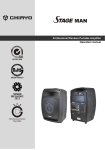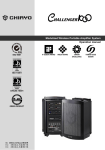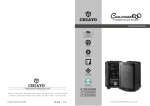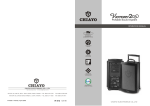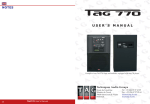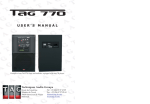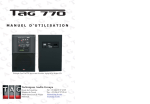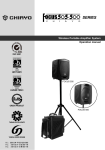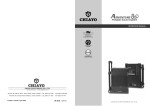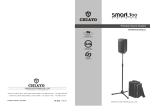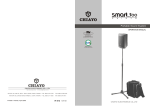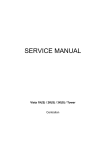Download Manual - Chiayo
Transcript
Modulized Wireless Portable Amplifier System Operation manual ISO 9001 R EG ISTER ED IS O 140 01 ISO 14001 R EG ISTER ED OHSAS 180 01 OHSAS 18001 GREEN PRODUCT IF DESIGN AWARD HKEIA AWARD TAIWAN EXCELLENCE TAIWAN GOOD DESIGN Please read and follow the instructions in this manual thoroughly to obtain optimum results from this unit. We also recommend that you keep this manual handy for future reference. Safety Precautions Be sure to read the instructions in this section carefully before use. Make sure to observe the instructions in this manual as the conventions of safety symbols and messages regarded as very important precautions are included. Safety symbols and messages described below are used in this manual to prevent bodily injury and property damage which could result from mishandling. Before operating your product, read this manual first and understand the safety symbols and messages so you are thoroughly aware of the potential safety hazards. WARNING Indicates a potentially hazardous situation which, if mishandled, could result in death or serious personal injury. CAUTION Indicates a potentially hazardous situation which, if mishandled, could result in moderate or minor personal injury, and/or property damage. Make sure to observe the following handling precautions so that a fire or personal injury does not result from leakage or explosion of the battery. Do not short, disassemble, heat or put the battery into a fire. Never charge batteries of the type which are not rechargeable. Do not solder a battery directly. Be sure to use the specified type of battery. Note the correct polarity when inserting a battery in the unit. Avoid locations exposed to the direct sunlight, high temperature and high humidity when storing batteries. WARNING To prevent the electromagnetic wave from badly influencing medical equipment, make sure to switch off the unit's power when placing it in close proximity to the medical equipment. CAUTION Battery discharge naturally according to a certain pattern even not in use. For best performance and a prolonged lifespan, battery should be charged regularly after every use or every month when the system is in storage and not being used! CD player optical pick up head is a very delicate device and sensitive to humidity. Please avoid using it in high humidity area to avoid damage! . -1- ISO 9001|ISO 14001|OHSAS 18001 VICTORY 2000 (Master) A,B&D. Slot for receiver/MP3/Bluetooth module C. Slot for receiver/transmitter/MP3/Bluetooth module E&F. Slot for other modules (CD player, DVD player, MP3+Bluetooth player…) 1. Mic-1 input 2. Mic-1 volume control 3. Music or speech mode selector 4. Mic-2 input 5. Mic-2 volume control 6. Line input/output 7. Line-in volume control 8. Tape/DVD power+volume control 9. Tone volume control (BASS) 10. Tone volume control (TREBLE) 11. Master volume control 12. Slave input A 13. Slave output 14. Master/slave selector switch 15. Master/slave volume control 16. Speaker out (switched) B 17. Speaker out (unswitched) 18. 24~32V DC input 19. Fuse E 20. AC input 21. Power switch 22. Power status indicator (RED) 23. Power status indicator (GREEN) 24. Voice priority F 25. Charging indicator 1 6 2 3 4 5 7 8 9 10 11 12 13 16 17 14 15 22 23 18 19 25 20 -2- 21 24 C D VICTORY Companion powered speaker A. Slot for receiver/MP3/Bluetooth module B: Slot for receiver/transmitter/MP3/Bluetooth module 1. Audio link input 2. Audio link output 3. Volume control 4. Speaker out (switched) 5. Speaker out (unswitched) 6. 24~32V DC input 7. Fuse 8. Power status indicator (RED) 9. Power status indicator (GREEN) 10. Charging indicator 11. AC input 12. Power switch A B 1 4 5 2 3 8 9 6 7 10 11 -3- 12 ISO 9001|ISO 14001|OHSAS 18001 VICTORY Companion passive speaker 1. Speaker input 2. Speaker output 1 -4- 2 Operating procedures After unpacking the unit for the first time, please charge the unit for at least 6 hours before operation. This is absolutely necessary as the built-in rechargeable batteries might have been discharged naturally due to long shipment and storage time, even though it has been fully charged in the factory prior to shipment. To operate this portable sound unit, switch on the main POWER switch, the GREEN LED above it will glow. However, if the RED LED also glows at the same time, it means the battery is getting weak and a recharge of the battery is necessary. The main POWER switch does NOT switch on the other devices as each of them has individual Power/Volume control. To operate each of them, you must switch them on accordingly. Operating the dynamic wired microphone To use a cable microphone, simply plug it into any MIC IN socket. The mic socket accepts both phone and Cannon jack. Rotate the dedicated volume control knob and master volume control, amplified sound could be heard from the speaker when voice is spoken into the cable microphone. When a full range high fidelity sound is emphasized, the mode selector should be put to MUSIC. For vocal frequencies where better clarity and projection is emphasized, put the mode selector to SPEECH and this will produce more mid-range frequency. Operating the wireless microphone system To operate the wireless system, just switch on the power/volume control on the module panel and the matching transmitter. Please set the same channel on both the transmitter and receiver before operation. Please as well make sure that master volume control is set to minimum level before turning the unit on, especially working on a wireless version! Set the Master volume control to the mid position. Rotate the volume control knob on receiver panel clockwise to the desired levels. When voice is spoken into the transmitter, amplified sound should be heard over the built-in speaker. Voice Priority (Ducking) operation Voice Priority operation is only necessary when CD or other acoustic device is playing. If the Voice Priority switch is put to ON position, the ducking function will be activated. While the music is playing, a voice input from either a wired or wireless microphone will temporarily override and turn down the volume of the background music and voice could be heard clearly. Background music will return to its original setting when no audio input is entering the microphone for a certain time. However, if the microphone is not switched off, the music entering the microphone will also activate the voice priority function. So, Voice priority is best operated using microphones with on/off switch. Battery Charging Internally, the VICTORY 2000 contains two 12V/5AH maintenance free lead acid batteries, which have no memory effect. When the batteries are weak, the power status indicator would stay RED. To charge the batteries, simply plug in the AC power supply, the charging process will start automatically. While charging, the charging indicator will flash GREEN. When batteries are fully charged, the charging indicator will stay GREEN. -5- ISO 9001|ISO 14001|OHSAS 18001 Speaker Out (switched) When an external speaker is connected to this output, the internal speaker of VICTORY 2000 will be muted and only the external speaker will have sound. Speaker out (unswitched) When an external speaker is connected to this output, both the internal speaker of VICTORY 2000 and the external speaker will have sound. Wired Audio Link The VICTORY 2000 could be operated as MASTER as well as SLAVE. This depends on the setting of Master/Slave selector switch. However, the VICTORY Slave can only be operated as SLAVE. In order to operate Audio Link, you must have a VICTORY 2000 unit that operates as a MASTER. Only one unit is allowed to act as MASTER and the other(s) MUST operate as SLAVE(s). A MASTER unit is capable of connecting up to about 20 SLAVE units. For the MASTER unit, the MASTER/SLAVE selector switch must be set to MASTER mode. The VICTORY SLAVE unit does not have this selector. If you have two units of VICTORY 2000, you could use one as Master and the other VICTORY 2000 as slave. To do that, just put the MASTER/SLAVE selector switch of the second VICTORY 2000 to SLAVE mode. For the MASTER unit, Audio Link IN jack should NOT be connected. To operate Audio Link, connect the Output jack of the MASTER to the Audio Link IN jack of the 1st SLAVE unit. The Output jack of this SLAVE should be connected to the Input jack of the 2nd SLAVE unit. Similar connection shall continue as such for the following SLAVE units. Volume Control for MASTER or SLAVE When used on the MASTER, it controls the MASTER as well as all the SLAVE units. When used on the SLAVE unit, it only controls that particular SLAVE unit volume. Maximum number of SLAVE units to be connected with a MASTER is about 20. -6- Remark : There should NOT be a connection between the last SLAVE unit output and the input of the MASTER unit. Wireless Audio Link Different from Wired Audio Link, with new SLAVE's capability of installation of receiver and transmitter modules it eliminates all cable connection and largely extends the number limit of SLAVEs. Application: For crowds of 1000 to 2000. (e.g., speeches or forums) Configuration: One Master + several R1 T2 SLAVEs (with receiver module built R2 in) T1 R2 Application: For crowds of over 3000. (e.g., stadiums) Configuration: One Master + several SLAVEs (with receiver and transmitter module built in) R7 R4 T7 T4 R6 R3 T2 T6 R1 R2 T3 R2 T1 PLATFORM T:Transmitter R: Receiver Module number:1,2,3,... T1 goes to R1, T2 goes to R2, T3 goes to R3, T4... -7- ISO 9001|ISO 14001|OHSAS 18001 SDR-5200M IrDA|SDR-5100M receiver modules 1. Channel indicator 2. Diversity A/B indicator 3. Audio signal indicator 4. IR sensor area 5. Channel Selector 6. IRDA synchronizing button 7. Squelch control 8. Power switch/volume control First turn on the Power of the main unit. Then turn on the individual power of the receiver module. Select a channel that corresponds to the transmitter. When transmitter is turned on, either A or B diversity indicator will flash to indicate that signal has been received. SQUELCH (SQ) setting When a channel is in use and undesired interference signal is received, turn the SQ in clockwise direction to make the receiver less sensitive and thus less susceptible to interference. If this still does not solve the problem, it means this frequency is not applicable at current position. Please switch over to the next channel. Channel synchronizing of the receiver and transmitter 1. To achieve a trouble-free synchronization, please limit the distance between the receiver and transmitter to within 30cm. 2. Align both sensor areas 3. To change the receiver’s channel, please press the synchronizing button of the transmitter. The transmitter will transmit synchronizing signal to the receiver and change its channel. 4. To change the transmitter’s channel, please press the synchronizing button of the receiver. The receiver will transmit synchronizing signal to the transmitter and change its channel. RP-5100M transmitter module This unit should be installed in the Master unit as a Repeater Transmitter to perform wireless link with the Slave unit. HI LOW 1. Channel indicator 2. Antenna socket(TNC type) 3. Channel selectors: Press ▲(up)▼(down) to increase/decrease channel number. Please select a non-interfering frequency channel to those already used in the master unit receiver modules. For wireless link to work, the channel of the corresponding receiver in the Slave unit should be matched. 4. Power switch. 5. Unit GAIN control: This controls the GAIN level of internal audio output. 6. 3.5mm audio input jack 7. AUX IN GAIN control: This controls the GAIN level of external audio input. 8. Output power setting: LOW (left) for Low output power and HI (right) for high output power. Low output power will reduce the RF transmission distance and High output power will extend the possible RF transmission distance. However, if the module is installed on batterypowered amplifiers, HIGH output power would reduce battery operating hour than LOW output power since it requires more power for stronger RF transmission. -8- DPRB-600M MP3 recorder player Bluetooth module 1 2 3 4 2 3 4 9 10 8 1 11 5 6 7 12 remote control of digital recorder player Bluetooth receiver section (LEFT) 1. Power/volume control 2. LINK button 3. LOCK LED 4. SCAN LED Linking instruction 1. Turn on the Bluetooth receiver and both SCAN and LOCK LEDs will flash alternatively. 2. Activate Bluetooth on your device and search new external Bluetooth devices. 3. Find and link to “Bluetooth Speaker” which is listed on your menu. 4. Once the linking is finished, the LOCK LED will flash green. 5. Pressing LINK button can cut the connection. Digital recorder player section (RIGHT) 1. LCD display 2. Press to return to previous track, press and hold to fast reverse. 3. Press to play/pause or stop recording. (readable formats: mp3, wav and wma) 4. Press to go to next track, press and hold to fast forward. 5. Press to record. 6. Press to switch repeat modes. 7. Press to stop playing or recording. 8. IR sensor area 9. USB input 10. USB/SD indicator: The LED flashes green during playing and red during recording. It lights red if there is no track to play, lighting green when playing or recording stops. 11. SD card input 12. Power switch/volume control -9- ISO 9001|ISO 14001|OHSAS 18001 Operating functions on the panel and the remote Operating function On the panel Press II Play/pause Record On the remote Press ● to record and II or ■ to stop. Press REC to record and II or ■ to stop. Skip forward Press I PressI Fast forward Press and hold I Press and hold I Skip backward Press I Press I Fast backward Press and hold I Press and hold I Next folder - Press Previous folder - Press Track select (button #0-9) - input track number, then press II USB/SD switch - Press USB/SD Press MODE Press MODE Repeat mode switch (ALL/SINGLE/FOLDER) Volume control - Press or A-B section play - Press A-B to start, again to play section and again to stop Delete tracks - Press DEL to delete track and again to confirm your delete Mute - press MUTE to mute/recover Note: Supports FAT and FAT32 file systems only. Supports MP3, WAV and WMA music formats only Record track format :MP3; Bit rate: 128kbps; Sampling frequency: 44kHz Recordable only when USB/SD is detected. Record files will be stored in the RECORD folder of USB/SD. The files will be named as FILE_001, FILE_002, FILE_003…etc. The name of a deleted track won’t be applied to its next one. Recordable until FILE_999 appears with LCD displaying Num Full. LCD displays USB FULL or SD FULL when insufficient memory left. LCD displays SD LOK if the SD is locked. Don’t remove the USB/SD during the recording process in case the interrupted track might be damaged. -10- Operating the CD player Parts and functions 2 3 4 5 11 1 6 7 8 9 10 1. LCD display 2. Play/pause 3. Stop 4. Rev-Skip-Cue Keys PLAY/PAUSE STOP FUNC UP/CUE DONW/REV 5. Eject 6. CD/USB selector 7. Repeat 8. Folder skip 9. Infrared receiving LED 10. USB input 11. Power/volume control Functions Panel Remote When this key is pushed during CD stop, play will start after track search. When this key is pushed during CD is playing, it will be changed to V V pause. When this key is pushed during CD is pausing, it will be changed to play. When CD is not stop, if this key is pushed then CD will stop. V V When press this key will change between CD and USB mode. V V In stop mode: Change the starting play track (file) during stop mode, cyclic to the first track, if it is in the last track. In program entry mode: Change to the next track(file) for program select . In play mode, pause mode, program play mode, random play mode: V V Single pressed, skip the playing track (file) to next track (file) for normal play/pause mode, to next program index track(file) for program play/pause mode, to next random track(file) for random play /pause mode. Continue pressed, fast forward during play/pause when pressed more than 0.7sec. In stop mode: Change the starting play track (file) during stop mode, cyclic to the last track, if it is in the first track. In program Entry mode: Change to the previous track (file) for program select. In play mode, pause mode, program play mode: V V Single pressed, skip the playing track (file) to precious track (file) for normal play/pause mode, to previous program index track (file) for program play/pause mode. Continue pressed, fast reverse during play/pause when pressed more than 0.7sec. -11- ISO 9001|ISO 14001|OHSAS 18001 FOLDER-UP In stop mode: Skip the starting play folder to next folder during stop mode, cyclic to the first folder if it is in the last folder. In program entry mode: Change the file for program select to next folder’s first file, cyclic to the first folder if it is in the last folder. In normal play mode: Skip the playing file to the next folder’s first file. FOLDER-DOWN In stop mode: Skip the starting play folder to previous folder during stop mode, cyclic to the last folder if it is in the first folder. In program entry mode: Change the file for program select to previous folder’s first file, cyclic to the last folder if it is in the first folder. In normal play mode: Skip the playing file to the previous folder’s first file. REPEAT In mp3 mode and in USB mode . If this key is pushed, PLAY mode is changed cyclically shown below. PLAY ALL RANDOM→REPEAT TRACK→REPEAT FOLDER→REPEAT ALL→RANDOM REPEAT→PLAY ALL IN CD mode If this key is pushed, PLAY mode is changed cyclically shown below. PLAY ALL RANDOM→REPEAT TRACK→REPEAT ALL→RANDOM REPEAT→PLAY ALL. EJECT When this key is pushed, door is moved out. PROG Set to programming mode. When programming mode, “stop” key is pushed then program is all cleared. MUTE When this key is pushed during CD is playing, the set will mute the output. Pushing again can recovery the output. POWER ESP ID3 0~10 VOL.VOL.+ Power SW of the set. In CDDA mode, Press ”ESP” key, The ESP display lighted and the set is in electronic anti-shock state. The electronic anti-shock time is about 40 seconds. Press “ESP” key again, cancel the ESP function. When this key is pressed , the“ID3”in the LCD display will flash, and the ID3 TAG is displayed pressing this key again will cancel the ID3 function You can use these keys to select the track you want directly. When this key is pushed, the volume will decrease by 1dB per step, the min. volume is 0dB. When this key is pushed, the volume will increase by 1dB per step, the max. volume is 30dB. V V V V V V V V V V V V V V V V V V Caution: This player does not accept 8-cm diameter CD. User is advised to have the USB 2.0 formatted in “FAT” or “FAT 32”. The built-in USB 2.0 player can not be able to read the MP3 files stored in your USB if it is not formatted by either “FAT” or “FAT-32”. To avoid damage to the USB, remember to detach it only after switching off the player. -12- Operating the DVD player Parts and functions 6 5 4 3 2 PLAY PAU SE 13 14 SD/MM C CARD 16 15 FU NC REV-SKIP-CU E REV CUE STOP EJECT REPEAT N /P 12 11 10 9 8 1. Power/volume control 2. Eject 3. Stop 4. Skip/forward 5. Skip/reverse 6. Play/pause 1 POWER / VOL VIDEO 7 7. Video output 8. N/P 9. Repeat 10. Cue 11. Rev 12. Function switch Keys 13. LCD display 14. IR LED 15. SD card input 16. USB 2.0 input Finction PLAY/PAUSE Press this key to change between PLAY and PAUSE modes. Panel Remote V V When this key is pressed during playing, the set is changed to stop. The stop point is memorized. Then pressing PLAY/PAUSE key, the set will play from the stop point. When this key is pressed twice during playing. The set is changed to stop, then pressing PLAY/PAUSE key, the set will play from the beginning. V V When this key is pressed, mode is changed between USB and disk. V V In play state, press “CUE” to do fast play. Each press of the key can change the play speed to X2, X4, X8, X20 and normal in sequence. V In play state, press this key to carry out the fast backward play. Every press the key, the backward play speed will change for one time.X2,x4,X8,X20 and normal in sequence. V Press the key to change the TV system in the following sequence: PAL→AUTO→NTSC→PAL→... V EJECT Press this key, the disk will move out. If the disk is not taken away, press this key again, the disk will slot in. V REPEAT The default is REPEAT ALL IN MP3 WMA state ,the repeat sequence is as following: REPEAT 1→REPEAT DIR→REPAT ALL→REPEAT 1→... In CD playing state , the repeat sequence is as following: REPEAT 1→REPAT ALL→REPEAT 1→... V STOP FUNC CUE REV N/P MUTE POWER GOTO When this key is pressed during disc is playing, the set will mute the audio output. Press again to recover the output. Power switch of the set. V V V V V Press GOTO to reach the title, chapter or time you want. V OSD In play state, press OSD key, the play information of the disc will show on the screen. Press it again, the OSD information will disappear. V PROG After programming, the player will play the title, chapter or songs follow the programmed order. V -13- ISO 9001|ISO 14001|OHSAS 18001 Press PROG button ,the menu will display on the screen as following: PROGRAM 1--:-2--:-3--:-4--:-- 5--:-6--:-7--:-8--:-- 9--:-10--:-11--:-12--:-play 13--:-14--:-15--:-16--:-clear In the picture T means TITLE, C means CHAPTER. The divided unit of DVD disc is title, and can divide the title for several chapters. Usually one movie has one title. Some disc are not divided in this way, please pay attention to it when operate GOTO” and “PROG” function. Input relevant title, chapter that you want with the arrows and number keys. Use ↑↓←→ to move the cursor to “PLAY” in the picture above, then press “ENTER” button .the player will start playing follow the programmed order. Also use the same way to move the cursor to “CLEAR” and press “ENTER” button can clean the programmed order. Press “PROG” key again will exit the program mode. PBC The key only act for VCD disc. V AUDIO In play state, press “AUDIO” key can choose different audio channels in the DVD disc. V ZOOM In play state, press “ZOOM” key ,the display screen will zoom by 2X, 3X, 4X, 1/2X, 1/3X, 1/4X and normal play. V SLOW Press “SLOW” key ,the set will become slow motion as following cycle: SF ½→SF 1/3→SF 1/4→SF 1/5→SF 1/6→SF 1/7→normal→SF ½→... V ↑↓←→ ENTER Cursor move keys and confirm keys. V REV-SKIPCUE Press one of these keys to skip to the next track, long press one of these keys will search forward or backward. ANGLE Press “ANGLE” to choose different angles of the disc that recorded with multi-angle. It doesn’t work if the DVD disc doesn’t support multi-angle. V When this key is pressed, it will become random play mode. V SUB-T In play state press “SUB-T” button to choose the different subtitles in the DVD disc. V SETUP Press “SETUP” key to enter setup manual. V TITLE Press “TITLE” key the screen will show title and manual for selection. V VOL.- When this key is pressed, the volume will decrease by 1dB per step, the minimum volume is 0dB. V VOL.+ When this key is pressed, the volume will increase by 1dB per step, the maximum volume is 40dB. V You can use these keys to select the track you want directly. V RANDOM 0~9;10+ -14- V V UHF handheld transmitters(SQ-6100 IrDA(R)|SQ-6100 IrDA|SQ-2100 IrDA|SQ-1100 IrDA) →SQ-6100 IrDA(R)|SQ-6100 IrDA →SQ-2100 IrDA 6 1 2 3 4 5 7 →SQ-1100 IrDA Parts and functions SQ-6100 IrDA(R) SQ-6100 IrDA SQ-2100 IrDA SQ-1100 IrDA Cartridge 1 1 1 1 Battery power LED 2 2 2 2 Power switch 3 3 3 3 LCD 4 4 - - Menu button 5 5 - - Setting button 6 6 - - IrDA synchronizing button 7 7 4 4 Battery compartment 8 8 5 5 Color cap 9 9 6 - IrDA sensor area 10 10 7 6 Charging port 11 - - 7 Battery installation & indicator This transmitter requires 2 x AA batteries to operate. To install, remove the battery cover and slide the batteries into the battery compartment & replace the battery cover. Note: Batteries contain a corrosive acid that may leak and damage the transmitter when stored for a long period. Batteries should be removed from the transmitter before storing without use for more than 4 weeks. When the transmitter is switched ON, a red LED will blink once to indicate the batteries installed are in good condition. If the LED remains illuminated, it means the batteries are weak and require replacement. -15- ISO 9001|ISO 14001|OHSAS 18001 Channel synchronizing of the receiver and transmitter 1. To achieve a trouble-free synchronization, please limit the distance between the receiver and transmitter to within 30cm. 2. Align both sensor areas 3. To change the receiver’s channel, please press the synchronizing button of the transmitter. The transmitter will transmit synchronizing signal to the receiver and change its channel. 4. To change the transmitter’s channel, please press the synchronizing button of the receiver. The receiver will transmit synchronizing signal to the transmitter and change its channel. Other settings(SQ-6100 IrDA(R)|SQ-6100 IrDA) 1. Channel setting Use MENU button to go to the CHANNEL|FREQUENCY page.︰ After pressing the SET button for 3 seconds, the cursor will flash to allow changes to be made. Pressing SET / MENU buttons will increase / decrease the channel number. The corresponding frequency will change accordingly. 3 seconds after selecting a channel, it will be automatically saved. 2. Battery type setting Use MENU button to go to the BATTERY TYPE page.︰ After pressing the SET button for 3 seconds, the cursor will flash to allow changes to be made. Press SET button to select either NiMH (rechargeable battery) or AKLN (alkaline battery). 3 seconds after selecting a battery type, it will be automatically saved. Remark: NiMH battery must be selected when rechargeable battery is being used. Never select AKLN (alkaline) when transmitter is intended for charging as alkaline battery isn’t rechargeable. Wrong battery selection will result in battery sensing electronics to display wrong and misleading status information. -16- UHF belt-pack transmitters(SM-7100 IrDA|SM-6100 IrDA|SM-2100 IrDA|SM-1100 IrDA) 1 1 6 7 4 8 9 2 3 4 5 5 7 10 8 9 2 10 11 12 14 3 3 6 13 15 11 Parts and functions 11 SM-1100 IrDA SM-7100 IrDA|SM-6100 IrDA|SM-2100 IrDA SM-7100 IrDA SM-6100 IrDA SM-2100 IrDA SM-1100 IrDA Antenna 1 1 1 1 LCD 2 2 - - Cover release button 3 3 3 6 Power switch 4 11 11 3 IrDA synchronizing button 5 5 5 7 Menu button 6 6 6 - Setting button 7 7 7 - High-impedance gain control (GT) 8 8 8 8 Low-impedance gain control (MT) 9 9 9 9 Battery compartment 10 10 10 10 Audio mute switch 11 - - - Battery power LED 12 12 12 2 IrDA sensor area 13 13 13 4 Mini XLR connector 14 14 14 5 Charging contacts 15 15 15 11 Battery installation & indicator This belt-pack requires 2 x AA batteries to operate. To install, open the battery cover using the cover release buttons and insert the batteries into the battery compartment. -17- ISO 9001|ISO 14001|OHSAS 18001 Note: Batteries contain a corrosive acid that may leak and damage the belt-pack when stored for a long period. Batteries should be removed from the belt-pack before storing without use for more than 4 weeks. When the transmitter is switched ON, the battery power LED (red) will blink once to indicate the batteries installed are in good condition. If the LED remains illuminated the batteries have expired and require replacement. Channel synchronizing of the receiver and transmitter 1. To achieve a trouble-free synchronization, please limit the distance between the receiver and transmitter to within 30cm. 2. Align both sensor areas 3. To change the receiver’s channel, please press the synchronizing button of the transmitter. The transmitter will transmit synchronizing signal to the receiver and change its channel. 4. To change the transmitter’s channel, please press the synchronizing button of the receiver. The receiver will transmit synchronizing signal to the transmitter and change its channel. GAIN setting (GT|MT) Gain control enables the user to set different output levels. GT is for the use of instrument with high impedance, such as guitar while MT is for the use of low impedance such as lapel or headset microphones. Other settings(SM-7100 IrDA|SM-6100 IrDA) 1. Channel setting Use MENU button to go to the CHANNEL|FREQUENCY page.︰ After pressing the SET button for 3 seconds, the cursor will flash to allow changes to be made. Pressing SET / MENU buttons will increase / decrease the channel number. The corresponding frequency will change accordingly. 3 seconds after selecting a channel, it will be automatically saved. 2. Battery type setting Use MENU button to go to the BATTERY TYPE page.︰ After pressing the SET button for 3 seconds, the cursor will flash to allow changes to be made. Press SET button to select either NiMH (rechargeable battery) or AKLN (alkaline battery). 3 seconds after selecting a battery type, it will be automatically saved. Remark: NiMH battery must be selected when rechargeable battery is being used. Never select AKLN (alkaline) when transmitter is intended for charging as alkaline battery isn’t rechargeable. Wrong battery selection will result in battery sensing electronics to display wrong and misleading status information. -18- Maintenance-free Lead Acid battery Guidelines for maintenance-free Batteries: 1. Battery should operate at temperatures between 15°C ~ 50°C. To ensure a longer life span, it should be kept between 5°C ~ 35°C. For optimum result, 20°C ~ 25°C will be ideal. When temperature falls 15 degrees below zero, battery will undergo some changes in its chemical contents and therefore cannot be recharged. Operating the battery at higher temperature will result in higher capacity but shorter lifespan, whereas lower temperatures operation has a longer lifespan but less capacity. 2. If the battery is not recharged 72 hrs after it is completely used, it will be permanently damaged. 3. When the battery is being charged, the internal gases will be electrolyzed into water at the negative charge, maintaining the battery’s storage abilities with no water added. However, erosion at the charged ends of the battery will cause poor performance. 4. The battery’s cycle lifespan (no. of charge and discharge cycle) is determined by the degree at which power is dissipated, especially the degree of discharged each time it is used and the recovery charging method. For normal use, the battery can be used for longer hours when less power is dissipated each time and vice versa. At 25°C, maintenance-free batteries could be charged 150 ~ 200 times at 100% discharge each time. 5. Decrease in capacity, internal short circuit, deformation in appearance, erosion of charged ends and decrease in open circuit voltage are symbols indicating battery is approaching the end of its life cycle. 6. When two batteries are used in parallel connection, the resistance of the cables should be kept equal. Properties of the Lead Acid Battery: 1. Has no memory effect. Can be charged anytime, even when the recharge indication light is off. 2. Performance and efficiency are affected by changes in the environment, especially temperature and humidity. (Best operated between 20°C ~ 25°C) 3. Battery discharge naturally according to a certain pattern even not in use. For best performance and a prolonged lifespan, it should be recharged every month even when not in use. 4. Under normal circumstances, battery could last for about a year. 5. When the battery’s life expires, possible indicators include internal short-circuit, decrease in capacity, deformation in appearance, erosion of charged ends and decrease in operating voltage. User’s Precautions: 1. For first-time use, charge the battery for 10 hrs until it is fully charged. 2. To maintain performance and lifespan, if product has not been used for 3 months after the initial shipment, please fully charge the battery. 3. Before each use, it’s advisable to charge the battery to its full capacity. 4. The average lifespan of the battery is one year. The user is advised to change the battery after one year of use. 5. The current consumption is in direct ratio with load current. The more current consumption, the less the operation time. 6. Warranty will be void if the battery is not charged for a prolong period as it may lose all its charge and could never be recovered again. CHIAYO ELECTRONICS CO.,LTD. Http://www.chiayo.com.tw|Email: [email protected] Office: 30, Lane 27, Section 4, Jen-Ai Road, Taipei 10685, Taiwan|Tel: 886-2-27415741|Fax: 886-2-27525242 Factory: 88, Chung-Hsiao Street 2, Chiayi 60080, Taiwan|Tel: 886-5-2711000|Fax: 886-5-5767611 -19-




















